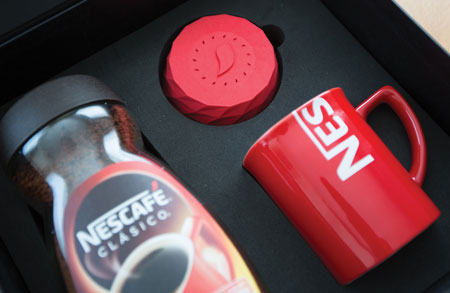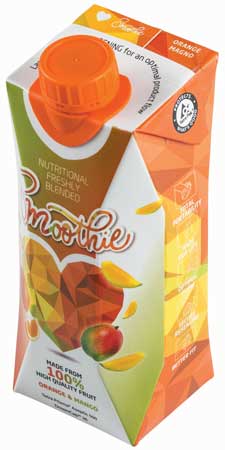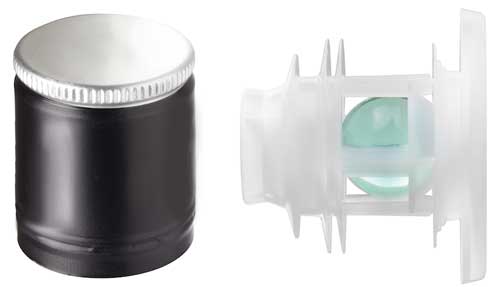Opening Innovation With Closures
PACKAGING
Every year, each consumer uses approximately 150 closures. Consumers interact with package closures when using products, so closures are the last chance to convey brand and product image. Demand for closures is projected to increase at a rate of 4.4% to reach an annual total of 2.2 trillion closures by 2019. Innovations in this area continue to enhance the consumer experience by adding an element of fun, enabling new product use, reducing food waste, and increasing sustainability.
 The use of closures to add customization and entertainment enhances a product’s image. Closures that add smell, additives, and fun offer increased possibilities for line extensions and new products. Consumers awaken to the smell of coffee when they open the lid to turn off the alarm on the Nestlé Nescafé Alarm Cap, designed by Publicis México, Cuajimalpa, México (publicis-mexico.com). The connection to waking up to Nescafé cannot be more obvious. Closures can monitor product consumption as well. For example, the Refresh Cap on Vittel bottled water has a timer that raises a flag when it is time to drink water. When the bottle is reclosed, the timer and flag reset. The use of packaging to impart functional additives is expanding rapidly and adding a health and fun element to the role of closures. These closures release powdered additives such as a flavor, nutrients, baby formula, iodine, and so on when attached to a bottle. This allows consumers to buy a closure and then twist it onto a bottle containing a beverage of their choice. The availability of such closures is growing rapidly; some of the companies that license the technology or produce the closures are Flava Cap LLC, Scottsdale, Ariz. (flavacaps.com); Tap-the-Cap Inc., Sherman Oaks, Calif. (tapthecap.com); Mix2Drink, British Columbia, Canada (mix2drink.com); Fresh Beverages International, Dublin, Ireland (freshbeveragesinternational.com); B-CAP, France (b-cap.eu); and Incap, Hong Kong, China (incap.hk). Scentsational Technologies, Jenkintown, Pa. (scentsationaltechnologies.com), expands the role of functional additives by embedding aromas within a closure. For example, sweet-smelling aromas can alter consumer product perception and reduce the need for added sugars in foods. Aromas can also convey product flavor by intensifying the existing aromas of products.
The use of closures to add customization and entertainment enhances a product’s image. Closures that add smell, additives, and fun offer increased possibilities for line extensions and new products. Consumers awaken to the smell of coffee when they open the lid to turn off the alarm on the Nestlé Nescafé Alarm Cap, designed by Publicis México, Cuajimalpa, México (publicis-mexico.com). The connection to waking up to Nescafé cannot be more obvious. Closures can monitor product consumption as well. For example, the Refresh Cap on Vittel bottled water has a timer that raises a flag when it is time to drink water. When the bottle is reclosed, the timer and flag reset. The use of packaging to impart functional additives is expanding rapidly and adding a health and fun element to the role of closures. These closures release powdered additives such as a flavor, nutrients, baby formula, iodine, and so on when attached to a bottle. This allows consumers to buy a closure and then twist it onto a bottle containing a beverage of their choice. The availability of such closures is growing rapidly; some of the companies that license the technology or produce the closures are Flava Cap LLC, Scottsdale, Ariz. (flavacaps.com); Tap-the-Cap Inc., Sherman Oaks, Calif. (tapthecap.com); Mix2Drink, British Columbia, Canada (mix2drink.com); Fresh Beverages International, Dublin, Ireland (freshbeveragesinternational.com); B-CAP, France (b-cap.eu); and Incap, Hong Kong, China (incap.hk). Scentsational Technologies, Jenkintown, Pa. (scentsationaltechnologies.com), expands the role of functional additives by embedding aromas within a closure. For example, sweet-smelling aromas can alter consumer product perception and reduce the need for added sugars in foods. Aromas can also convey product flavor by intensifying the existing aromas of products.
The environmental and monetary costs associated with shipping liquids in bottles suggests that closures will play a role in improving sustainability, increasing the availability of customizable beverages, and decreasing costs. With minimal additional weight and a modified application, StackCaps by Bericap, Budenheim, Germany (bericap.com), can be fitted together to create small toys and connected to bottles to create towers and poles and other structures. Customization and brand identity derived from closures go beyond beverages. For example, Frizle pasta dough can be squeezed through holes in an ultrasonically sealed polyethylene lined carton by Spiegel Verpackungen, Höchberg, Germany (spiegel-verpackungen.de). This allows fresh pasta to be extruded easily and cooked at home. Innovation in closures makes new products and expanded brand image possible.
 There is a dichotomy between the need for efficient packaging and sealing operations and the needs of consumers using packages. Because the need for strong package sealing in a manufacturing environment is not always aligned with how consumers open and then use packages, packaging designers are more frequently separating the sealing processes used in manufacturing from the closure features desired by consumers. This is especially true with processes that require heightened seal integrity and specific seals, such as in aseptic cartons, retort cans, and high-pressure-processing pouches. DreamCap by TetraPak, Pully, Switzerland (tetrapak.com), is a mildly inflated name for a closure that does not require the consumer to peel an inner seal after removing the closure at the first time of use. An integrated cutting mechanism within the inner thread of the closure cuts through the seal when the outer closure is initially opened by the consumer. This provides the needed seal as well as eliminates a step for consumers to use the product. The consumer preference for drinking from a wide mouth container is addressed by a separable top by TetraPak that allows consumers to peel off the container top, revealing a cup. The separation also allows for ease of separation for recycling. Also in alignment with how consumers use product versus simply reversing the manufacturing sealing process is the flip-top cap manufactured by VIP Packaging, Victoria, Australia (vippackaging.com.au), for Devondale cream. The flip-top appeals to consumers and incorporates a traditional induction tamper-evident seal. When the container is flipped open, the integrated scoop is removed and the consumer peels back the foil liner with a pull ring. The scoop between the tamper evident inner seal and underside of the closure was facilitated by welding the closure to the container using bonded aluminum to plastic.
There is a dichotomy between the need for efficient packaging and sealing operations and the needs of consumers using packages. Because the need for strong package sealing in a manufacturing environment is not always aligned with how consumers open and then use packages, packaging designers are more frequently separating the sealing processes used in manufacturing from the closure features desired by consumers. This is especially true with processes that require heightened seal integrity and specific seals, such as in aseptic cartons, retort cans, and high-pressure-processing pouches. DreamCap by TetraPak, Pully, Switzerland (tetrapak.com), is a mildly inflated name for a closure that does not require the consumer to peel an inner seal after removing the closure at the first time of use. An integrated cutting mechanism within the inner thread of the closure cuts through the seal when the outer closure is initially opened by the consumer. This provides the needed seal as well as eliminates a step for consumers to use the product. The consumer preference for drinking from a wide mouth container is addressed by a separable top by TetraPak that allows consumers to peel off the container top, revealing a cup. The separation also allows for ease of separation for recycling. Also in alignment with how consumers use product versus simply reversing the manufacturing sealing process is the flip-top cap manufactured by VIP Packaging, Victoria, Australia (vippackaging.com.au), for Devondale cream. The flip-top appeals to consumers and incorporates a traditional induction tamper-evident seal. When the container is flipped open, the integrated scoop is removed and the consumer peels back the foil liner with a pull ring. The scoop between the tamper evident inner seal and underside of the closure was facilitated by welding the closure to the container using bonded aluminum to plastic.
The prevalence of flip-top closures with integrated tamper evidence and no-drip lip features is increasing in the dressing and sauces categories as well. Hinged closures by Bericap employ these features while utilizing less polymers to lower the environmental footprint. Suero Oral Inc. selected a bottle with a polypropylene flip-top lid by TricorBraun, St. Louis, Mo. (tricorbraun.com), for an extension to its hydrating additives offerings. The new Suero Oral two-ounce container provides greater ease of consumer opening and use compared to the established 500-milliliter and 1-liter sizes. The flip-lid and latch feature of FlexFit, a one-piece high density polyethylene closure by WestRock, Richmond, Va. (westrock.com), stops product from flowing onto the closure. When closure design is focused on consumer product use needs, such innovation is possible.
Closures have the ability to control portions. Regulations require a child-resistant closure and the ability to measure dosages of cannabis-infused products by Dixie Elixirs & Edibles. At the time of the regulation, a resealable closure with dosage capabilities for a carbonated product did not exist. This led to a new closure to match the product requirements and the metering of a dosage of cannabis of less than 10 milligrams of tetrahydrocannabinol: a pinch-and-close jigger closure with integrated measuring by TricorBraun. Packaging for household cleaning demonstrates what else is possible. The smart dosing cap developed by Aptar, Crystal Lake, Ill. (aptar.com), for Mr. Clean and other cleaning products employs a piston and timer for up to 50 milliliters of product to be dispensed. Walgreen’s Good & Delish nuts are capped with a closure that doubles as a portion-controlled single-serving bowl and polypropylene screw-top closure. Since the new package was introduced, sales of Good & Delish nuts have increased by 23%.
Closure innovations are enabling sustainability and extended shelf life for products in metal cans and bottles. Advances in neck and finish integration have made the use of Cap Can for Noah’s Spring Water possible. The unique resealable 38-millimeter lug thread closure by Dayton Systems Group, Miamisburg, Ohio (daytonsystemsgroup.com), is applied to the 24-ounce aluminum can. The large closure allows for a high flow rate for ease of drinking and refilling at a cost that is 50% – 75% less than that of a standard refillable aluminum water bottle. The MB-Lok 28mm by Closure Systems International, Indianapolis (csiclosures.com), was chosen for two-liter Eibauer beer cans. The closure has a liner containing 3.8 milliliters of carbon dioxide to extend shelf life after opening.
 The study “Recipe for Change: The Flexible Food Processing Plant of the Future” presents solutions to the conundrum of dedicated manufacturing and the need for supple package designs. The evolution of the aluminum closures of Coca-Cola bottles since 2005 demonstrates the need for varied solutions over three generations. The first generation in 2005 was a pry-off crown closure followed by a pull ring onto a crown closure. In 2008 the second generation offered resealability in a proven roll-on pilfer proof (ROPP) aluminum closure. These closures were viable because the impact-extruded bottle was strong enough to support applications of crown and roll-on closures. But when a bottle weight reduction of 40% became possible through innovations in draw-and-iron fabrication technology, the bottle neck no longer supported the demanding crown or ROPP closure applications. The solution by Coke and Fowler Products, Athens, Ga. (fowlerproducts.com), was to use two revolutions to both seal the ethylene vinyl acetate gasket and apply threads to the aluminum closure by balancing the required 250-pound force. Not only did this solution allow the reduction of bottle weight by 40%, it also maintained the resealability feature. And evidence of tampering is elegantly addressed by the TIVA2 by Global Closure Systems, Saint-Cloud, France (gcs.com), for the spirits market. By carrying the valve inside the shell before capping, production changeovers from the previous closure were minimal, allowing for a design change.
The study “Recipe for Change: The Flexible Food Processing Plant of the Future” presents solutions to the conundrum of dedicated manufacturing and the need for supple package designs. The evolution of the aluminum closures of Coca-Cola bottles since 2005 demonstrates the need for varied solutions over three generations. The first generation in 2005 was a pry-off crown closure followed by a pull ring onto a crown closure. In 2008 the second generation offered resealability in a proven roll-on pilfer proof (ROPP) aluminum closure. These closures were viable because the impact-extruded bottle was strong enough to support applications of crown and roll-on closures. But when a bottle weight reduction of 40% became possible through innovations in draw-and-iron fabrication technology, the bottle neck no longer supported the demanding crown or ROPP closure applications. The solution by Coke and Fowler Products, Athens, Ga. (fowlerproducts.com), was to use two revolutions to both seal the ethylene vinyl acetate gasket and apply threads to the aluminum closure by balancing the required 250-pound force. Not only did this solution allow the reduction of bottle weight by 40%, it also maintained the resealability feature. And evidence of tampering is elegantly addressed by the TIVA2 by Global Closure Systems, Saint-Cloud, France (gcs.com), for the spirits market. By carrying the valve inside the shell before capping, production changeovers from the previous closure were minimal, allowing for a design change.
Closures increasingly enable new products, variety, and sustainability while reducing food waste.
 Claire Koelsch Sand, PhD, Contributing Editor
Claire Koelsch Sand, PhD, Contributing Editor
President, Packaging Technology and Research
Adjunct Professor, Michigan State Univ.
[email protected]
